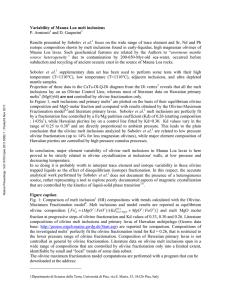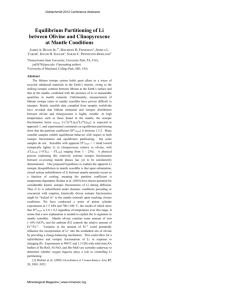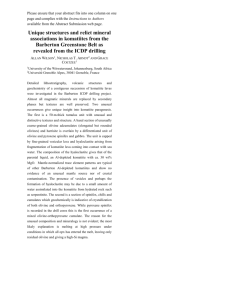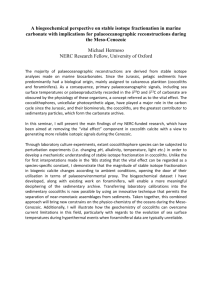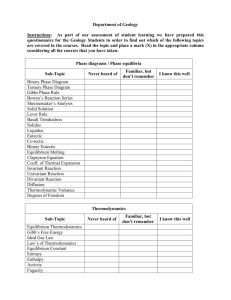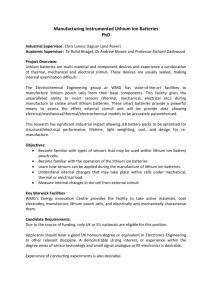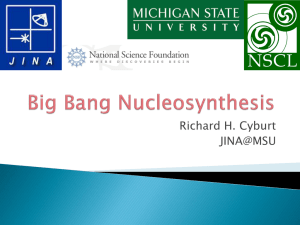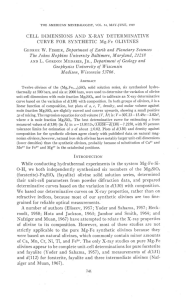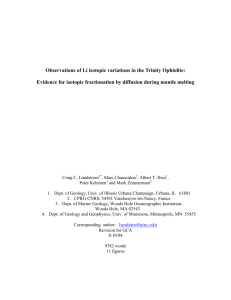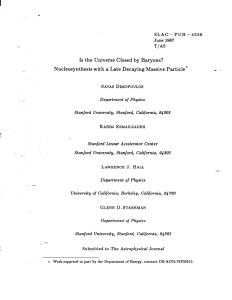High-spatial resolution lithium isotope variation in mantle
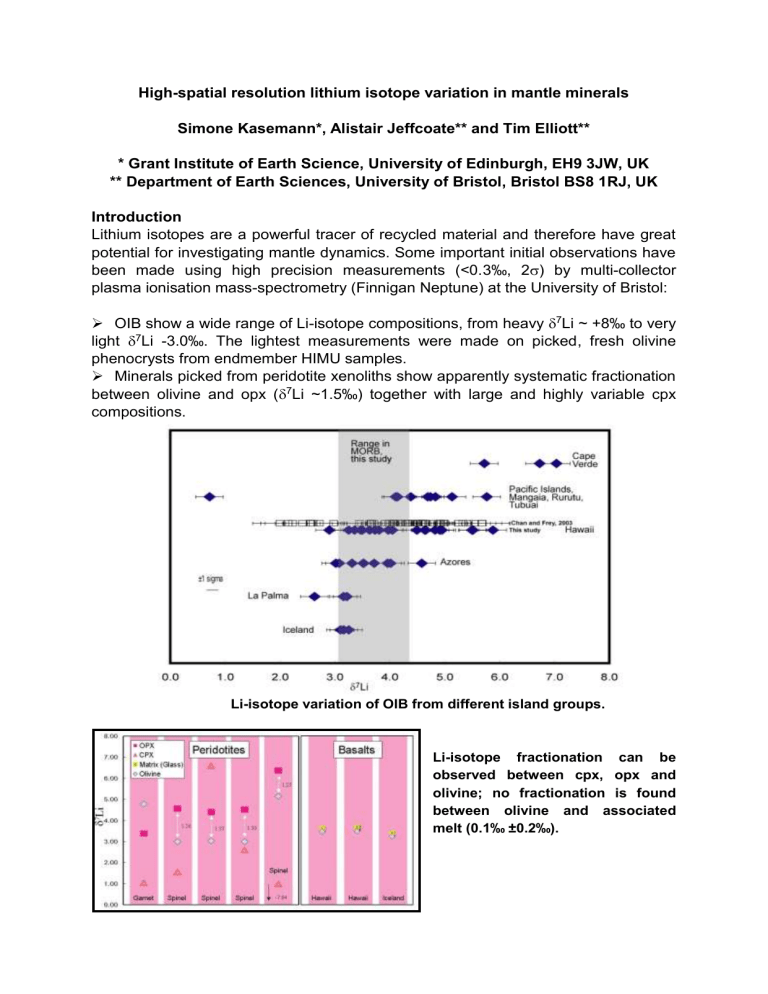
High-spatial resolution lithium isotope variation in mantle minerals
Simone Kasemann*, Alistair Jeffcoate** and Tim Elliott**
* Grant Institute of Earth Science, University of Edinburgh, EH9 3JW, UK
** Department of Earth Sciences, University of Bristol, Bristol BS8 1RJ, UK
Introduction
Lithium isotopes are a powerful tracer of recycled material and therefore have great potential for investigating mantle dynamics. Some important initial observations have been made using high precision measurements (<0.
3‰, 2
) by multi-collector plasma ionisation mass-spectrometry (Finnigan Neptune) at the University of Bristol:
OIB show a wide range of Li-isotope compositions, from heavy
7 Li ~ +8‰ to very light
7 Li -
3.0‰. The lightest measurements were made on picked, fresh olivine phenocrysts from endmember HIMU samples.
Minerals picked from peridotite xenoliths show apparently systematic fractionation between olivine and opx (
7 Li ~ 1.5‰) together with large and highly variable cpx compositions.
Li-isotope variation of OIB from different island groups.
Li-isotope fractionation can be observed between cpx, opx and olivine; no fractionation is found between olivine and associated melt (0.1‰ ±0.2‰).
Aim
High-spatial resolution Li-isotope analyses by secondary ionisation mass spectrometry (Cameca ims 1270 & 4f) at the University of Edinburgh were conducted to investigate in more detail the result of the bulk analyses, specifically:
if anomalously light Li-isotopic signatures noted in a few HMU olivines are representative of the mantle source or secondary olivine alteration
if in-situ measurements of peridotite phases indicated isotopic equilibrium
Example of microscale variations in lithium concentration and isotope composition observed in OIB olivine. The concentrations are given in brackets.
The average uncertainty on
7 Li is ~ ±0.8‰ (1 mean
, for [Li] of 1.5-2
g/g).
7 Li profile on olivine (1.4
g/g [Li]) and orthopyroxene (0.8
g/g [Li]) from a fertile spinel lherzolite. The isotope variation of up to 8‰ is not correlated with major element composition. The standard deviation on the PIMMS data is <0.3‰ (2
); the uncertainty on the SIMS data is given as 1
mean
.
Results
The extremely light
7 Li values of some OIB olivines are not the result of secondary alteration but must represent the original source material
7 Li profiles on olivines and opx show a large isotope variation of up to 10‰.
The trend in
7 Li from core to rim can be from light to heavy and vice versa.
Preliminary data on peridotite phases indicate isotopic disequilibrium within mantle minerals
Micro-scale alteration processes in OIB olivines can modify the original a) Li concentration from 1.5 to 20 mg/g b) Li-isotope signature to both lighter and heavier values.
This can cause problems when using bulk mineral measurements as representative of the "pristine" whole rock
Multi-collector secondary ionisation mass spectrometry Cameca ims 1270
Positive secondary ions ( 6 Li + , 7 Li + ) were produced by a 10 nA, 20 kV, O primary beam and analysed with an energy window of 30 eV, a 150 mm image field, a 400 mm contrast and 5028 mm field apertures and a mass resolution of 6300. Liisotopes were measured simultaneously using electron multipliers. The spatial resolution (kohler illumination) was ~ 25 mm. The exter nal uncertainty is <0.5‰
(1
mean
) for samples of < 5 ppm Li. The expected uncertainty is about 0.2‰ (1 mean
).
Single-collector secondary ionisation mass spectrometry Cameca ims 4f
Positive secondary ions ( 6 Li + , 7 Li + ) were produced by a 10 nA, 14.5 kV, O primary beam. Secondary ions were analysed with an energy window of 52 eV, a 150 mm image field and a mass resolution of ~ 1200 (to resolve internal uncertainty of <1‰ (1
6 Li 1 H + ). To get an mean
), the Li-isotope ratio was measured for 120 cycles
(EM), each cycle consisting of 2 and 5 sec count times on 6 Li + and 7 Li + , respectively.
The spatial resolution was < 20 mm.
The instrumental mass fractionation for lithium is stable at the per mil level within a one week analytical session as shown by the repeated lithium analyses on the synthetic GSD-1G glass.
Daily average in Li-isotope ratio for 4 days on GSD-1G.
To investigate the precision of Li-isotope measurement, microanalytical reference materials from the National Institute of Standards and Technology (NIST) and U.S.
Geological Survey (USGS) were analysed. This material includes synthetic (e.g.
NIST SRM 612, GSD-1G) as well as natural (BCR-2G, BHVO-2G) reference glass with a lithium concentration from 1 to 480
g/g.
Multiple Li-isotope analysis of BCR-2G, the external reproducib ility is 0.9‰ (1
)
Multiple Li-isotope analysis of BHVO2G, the external reproducibility of 0.7‰ (1
).
A comparison between PIMS, TIMS and SIMS data show an agreement of better than 1‰, based on analysed natural and synthetic USGS glasses. Using USGS glasses and minerals (e.g. olivine, cpx) no matrix dependent fractionation on lithium isotope ratios have been observed. Exception for NIST SRM glasses.
